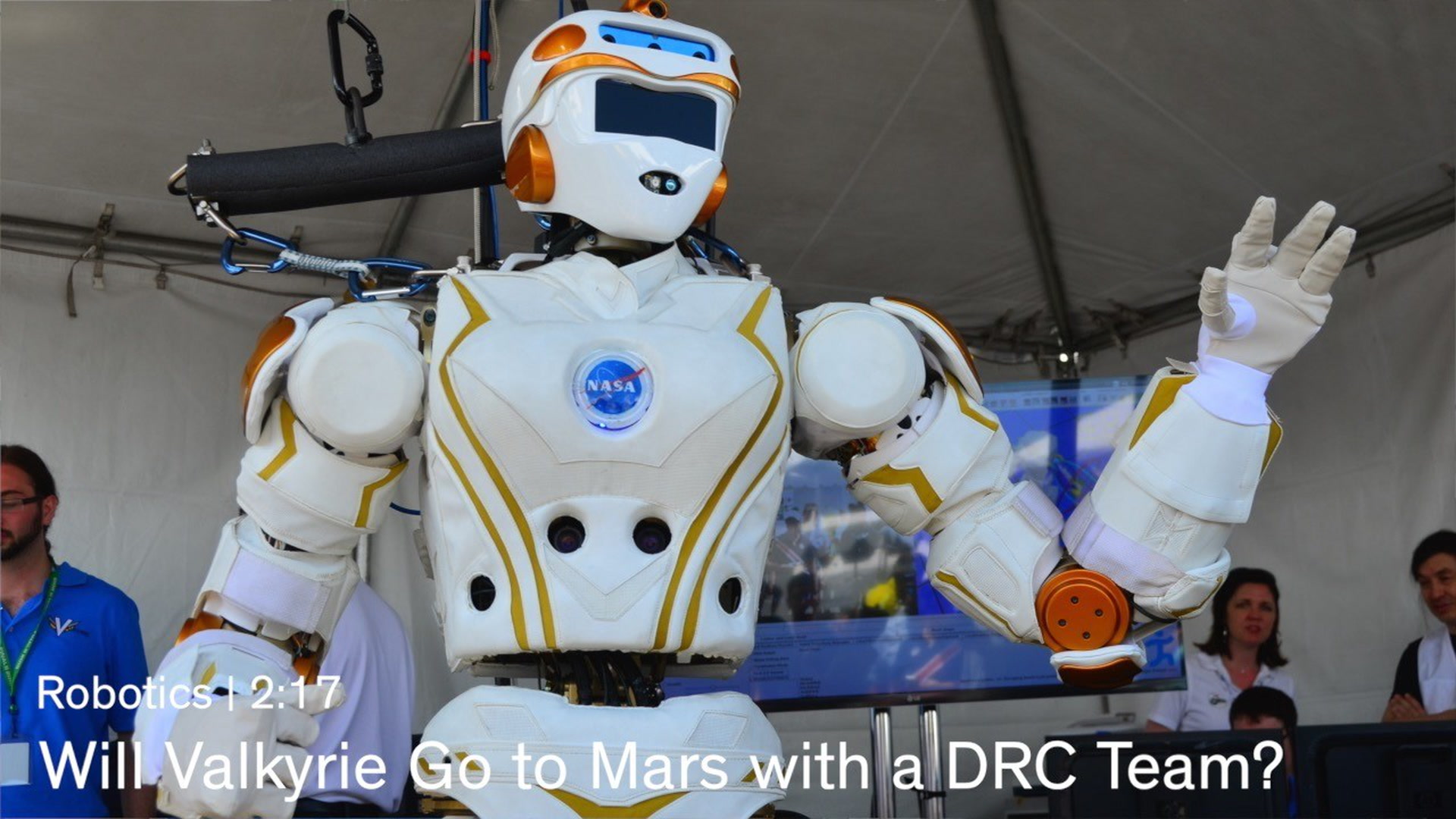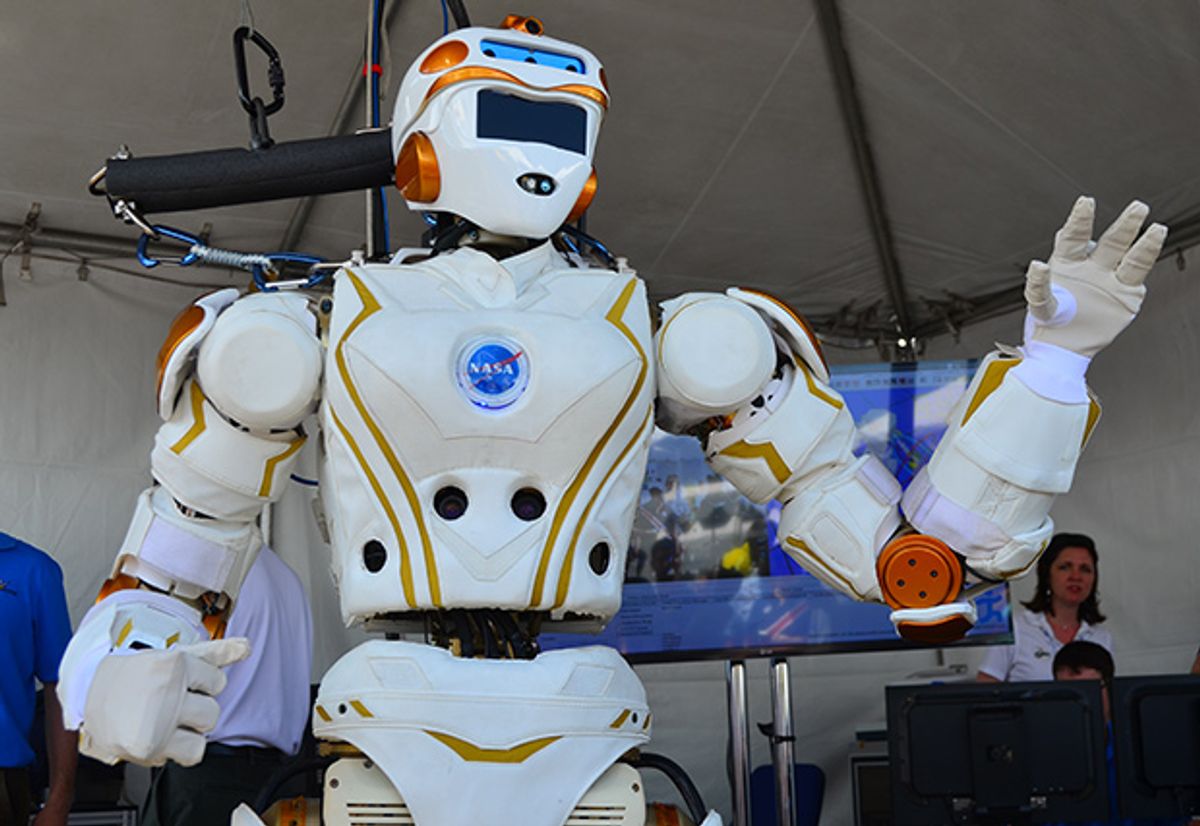NASA’s Valkyrie robot didn’t have a very good time at the DARPA Robotics Challenge (DRC) Trials. There are a bunch of good reasons for this, but our concern has always been that NASA would see the DRC Trials as a failure of the robot and the program and just give up. We should have had more faith, because NASA is in this for the long game, and so is Valkyrie. And where does the long game end? Mars. And beyond.
At the exhibit area that was part of the DRC Finals earlier this month, NASA had two Valkyrie robots on display, and they even performed a brief demonstration involving both mobility and manipulation. We got a chance to speak with the Valkyrie team, including project manager Kris Verdeyen, about the future of Valkyrie.

NASA’s Space Robotics Challenge (SRC) has a focus on space operations in general, and Valkyrie specifically. NASA and the National Science Foundation have put some funding together to enable a couple of U.S. university teams that participated in the DRC to host a Valkyrie robot to (hopefully) keep humanoid robotics research advancing post-DRC. It’s part of NASA’s Game Changing Development Program, and here’s an excerpt from the research announcement. I apologize in advance for the wall of text, but it does a good job of clearly articulating why NASA is so interested in this; note that officially, NASA refers to Valkyrie as “R5:”
NASA initiated the design and development of a new bipedal humanoid robot, R5, through the DARPA Robotics Challenge (DRC) in 2012. While developed specifically for disaster-response tasks, R5 was also envisioned as part of a new category of robots for use in future NASA missions, either as a pre-cursor robot performing mission tasks before humans arrive, or as a human-assistive robot actively collaborating with the human crew.
NASA seeks to stimulate innovation in the operations and capabilities of existing and future humanoid robots with a focus on the performance of tasks related to space exploration missions. NASA’s interests in humanoid robots derives from their latent ability to more effectively and efficiently operate equipment engineered for humans and their ability to function effectively as astronaut assistants. These NASA interests for the use of humanoid robots in extreme space environments also overlap with the potential utility of similar robots in terrestrial applications such as disaster relief.
To maximize the diversity of innovation, NASA is assembling two additional R5 units that will be provided as Government Furnished Equipment (GFE) for at least two years to the robotics community for active research of high-level humanoid behaviors. The robots will have walking, balancing and manipulating capabilities so that future research may focus on the development of complex behaviors that would advance autonomy for bipedal humanoid robots.
NASA is saying that there’s a lot of crossover between robots that can function in disasters, and robots that can function in other extreme environments, which includes outer space, or Mars. The overall idea is that before we send humans to Mars, we send a spaceship full of Valkyries instead. The Valkyries can operate on Mars without needing any sort of life support systems, and they can spend however long they need setting things up for us fragile beings.
Once a base is up and running and confirmed habitable, we can show up, and then the Valkyries will stick around to work alongside the human Marstronauts, taking care of maintenance and other tasks that we wouldn’t want to waste our time on. Up on the International Space Station right now, Robonaut is supposed to be doing the same sorts of things, taking over maintenance tasks from the astronauts who have better things to do. Frustratingly, the astronauts haven’t yet had enough time to finish setting up the robot that’s supposed to give them time to do stuff like setting up robots. Sigh.
Anyway, back to Valkyrie. NASA specifically wants teams that have participated in the DRC to host the Valkyrie robots, but they’re well aware that a lot of these teams have been killing themselves for the last three years, so NASA’s plan isn’t to design another DRC-scale robotics challenge. The first stage of the SRC will be virtual, followed by a physical event. Here’s the deal:
The SRC will consist of a virtual competition using robotic simulations followed by a physical competition using NASA-provided robots, which include those hosted by awardees. [This is] a competitive selection process for the award of up to two (2) cooperative agreements whereby each of the two (2) awardees will be provided an R5 robot as Government Furnished Equipment (GFE) for a period of at least two years. In addition to the robot, NASA will provide support and maintenance, both remotely and on-site, and up to $250,000 funding per Recipient per government fiscal year during the performance period. Recipients are expected to perform basic and applied research and software development to increase the autonomy of the R5 robots during the performance period. During year two of the performance period, Recipients will provide SRC competitors with access to the R5 robotic unit. NASA believes that providing access to the R5 robotic platform to multiple robotics research groups serves a public purpose by progressing the technological readiness of humanoid robotic autonomy for success in future space missions.
The virtual SRC is scheduled to take place in September 2016, and the highest scoring teams from that competition will be given access to the Valkyrie robots (wherever they end up) to prepare for the physical challenge one year later, in September of 2017. The specific details on the challenges haven’t been released yet (this solicitation is just to see where the robots themselves go), but here’s the sort of thing NASA has in mind, and whoever ends up with the Valkyrie robots will figure out if the stuff on this list is a reasonable challenge for the SRC:
-
Exit a habitat airlock hatch and use a ladder to reach the terrestrial surface
Combines the ability for a robot to conform its body to a pre-defined area with the ability for the robot to traverse stairs. Traversing stairs will also require development of motion for a humanoid robot with multiple contactpoints and constraints.
-
Remove a communications/power cable from a soft-goods storage location and attach it to a connector located at least 10 meters away, while traversing an irregular rocky terrain, like the surface of Mars
Combines manipulation of non-rigid structures, manipulation of multiple objects into one object (connection), and perception of mobility obstacles.
-
Repair or replace damaged components on complex equipment, such as a broken valve or a damaged tire on a planetary rover
Involves complex manipulation of possibly small items with the need for following precise procedures.
-
Collect or recover desired samples or items, such as Mars soil and/or rocks
Combines manipulation of human-rated tools with mobility while using those tools.
If you’d like a Valkyrie of your very own, check out the full solicitation here, although keep in mind that you need to be a U.S.-based university that has participated in the DRC. We’ve also heard that the University of Edinburgh is getting its own Valkyrie if you’re in Europe and want to play with one. We’ll be sure to keep you updated on the SRC itself; since the virtual challenge is only a bit over a year away, we’re expecting to get lots of details soon.
[ NASA ]
Evan Ackerman is a senior editor at IEEE Spectrum. Since 2007, he has written over 6,000 articles on robotics and technology. He has a degree in Martian geology and is excellent at playing bagpipes.






